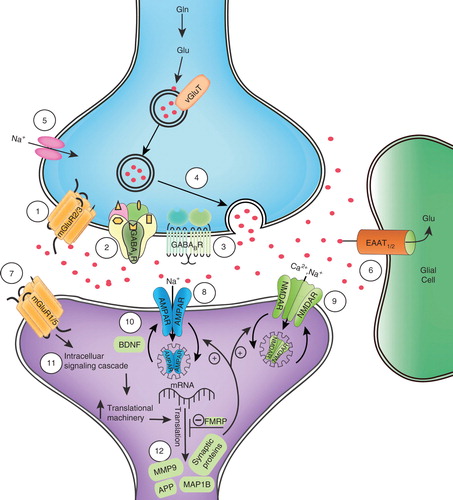Figures & data
Figure 1. Illustration of potential targets for drug therapy at a glutamatergic synapse in FXS. When stimulated by presynaptic glutamate release, postsynaptic mGluR1/5 receptors activate intracellular signaling cascades that mobilize translational machinery to translate mRNA into synaptic proteins, examples of which include MMP-9, MAP1B and APP. FMRP inhibits translation of more than 500 target mRNAs in the normal state; in FXS, this negative feedback mechanism is absent or severely reduced, leading to excessive protein synthesis and altered synaptic plasticity. Consequences of increased synaptic protein synthesis include loss of AMPARs and NMDARs from the postsynaptic membrane via endocytosis. Drugs that modulate excitatory glutamatergic and inhibitory GABAergic neurotransmission have the potential to alleviate some phenotypic effects in FXS. Key for labeled mechanisms of action and corresponding drugs: 1) LY2140023 (mGluR2/3 agonist); 2) acamprosate (GABAAR agonist); 3) arbaclofen (GABABR agonist); 4) riluzole (blocks presynaptic glutamate release); 5) riluzole (blocks voltage-dependent sodium channels); 6) riluzole (enhances glutamate reuptake); 7) MPEP, fenobam, AFQ056, RO4917523, STX107, CTEP, acamprosate (mGluR5 antagonists); 8) CX516 (ampakine); 9) memantine (weak NMDA antagonist); d-serine, d-cycloserine, GLYX-13 (glycine site NMDAR partial agonists); 10) lithium, CX516 (increase BDNF); 11) lithium (GSK3 inhibition); 12) minocycline (MMP-9 inhibition).

Table 1. Comparison of Phase II and III clinical trials in FXS.
